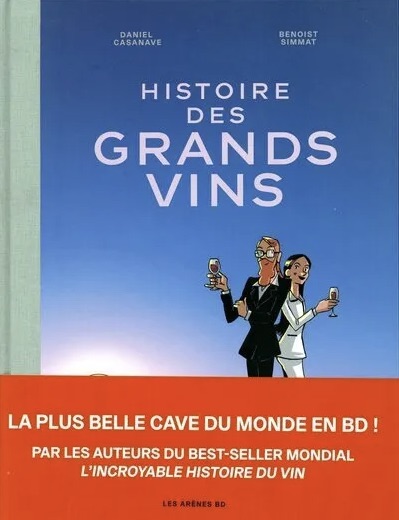

Double news for this regular contributor to Capital, formerly at the JDD or the Revue du Vin de France: with illustrator Daniel Casanave, he has written Histoire des Grands Vins and a new edition of L’Incroyable Histoire du Vin, which has sold over 130,000 copies in France since its first publication in 2019. A story that deserves a spotlight…
How does one go from business journalist to comic book scriptwriter?
As is so often the case, it’s all down to chance. In September 2001, as a young journalist at the JDD, specialising in the stock market and heavy industry, one of the editors asked me to write about wine, from an economic angle of course. And there I was, sitting by the fire in the middle of the Sauternes vineyards, looking out over the vines as the sun set, with a glass of Sauternes 1970 in my hand, listening to the winemaker who had produced it. A suspended moment. A powerful memory. I realised that wine, an agricultural product with a history stretching back thousands of years, is first and foremost a quest for exceptional moments. I took a keen interest in it. For ten years or so, I covered the subject in the press, always from an economic or political point of view. Until I started writing books, on economics and politics. In 2010, a publisher whose profile I’d been working on pointed out to me that there were no comic books about wine in France: ‘You should come up with a script…’. He was Laurent Muller, who at the time was head of 12bis and is now editorial director of Les Arènes BD. Some time later, my first comic book as a scriptwriter, Robert Parker: les sept péchés capiteux, came out. This marked the start of a new professional life, divided between the press on the one hand and books and documentary comics on the other…
Documentary comics are now part of the publishing landscape. How do you explain its success?
First of all, this success is recent. It really began with Le Monde Sans Fin by Jean-Marc Jancovici and Christophe Blain. That was in 2021, just three years ago… For the rest, documentary comics provide a kind of reading comfort. They make it easier for people who are both curious and gourmand, and who are interested in specific subjects from a historical perspective, to grasp them without completely abandoning essays, whose sales, for their part, are at half-mast. We mustn’t forget that comics are a medium, and therefore an aid to reading.
Why does wine lend itself to this genre?
Precisely because it occupies a very special and extremely important place in the history of humanity. It has accompanied mankind and most of its civilisations since their earliest origins. No other drink has had such a destiny. Before being synonymous with the pleasure of tasting, wine is first and foremost a cultural and social vehicle. L’Incroyable Histoire du Vin has, I believe, restored wine to its rightful place.
How do you structure your story when faced with so much history, so many facts, so much information, so many developments…?
Before writing, it’s important to know how to sort things out. In this area, I apply more or less the same ‘scientific’ method as any essay writer: retaining the most salient elements to create a story that will be brought to the attention of the reader. Except that I’m more constrained: because the story is told through drawing, 80% of the information cannot be retained. So my role is to keep only the best. To do this, I concentrate on the most recognised specialists and, more specifically, their research articles, the ones on which they base their own books. In 20 pages, you have the quintessence of a book. It’s infallible! I recommend it to all my colleagues. From there, I can choose the eras, or rather the innovations, and move from one to the next. Because that’s what it’s all about: in the case of wine, it’s developments in winemaking, in the commercial market, in tasting… that punctuate its history. Armed with this knowledge, I can get started.
And what about the illustrator?
Daniel Casanave brings a lot to the table. He adds the setting and the context to the writing. He does a major job of depicting history, the landscapes, the people, the costumes…
Let’s take a closer look at each of your last two comic books, starting with L’Incroyable Histoire du Vin. What’s new in this 5th edition?
The main one is the addition of a major chapter, this time on a vineyard rather than a theme such as ecology, rosés or bubbles…. We wanted to highlight a remarkable wine-growing region. After giving it a lot of thought, we decided on Beaujolais. For three reasons. Firstly, because this vineyard is the result of a remarkable marketing operation that has put it on the map worldwide, to the point where it now shares the limelight with Bordeaux, Burgundy, Champagne and Cognac. Secondly, it is less well known, but it has a long history behind it, at the crossroads of all our accounts of the history of wine in Europe. Finally, it stands out for an aspect little explored until now in the book: geology. It is unique in France, and indeed in the world. There’s a veritable puzzle of siliceous clay soils, calcareous sandstone, marl, granite, volcanic rock, gneiss and more, making it a land of conquest for a whole host of young winemakers who are in the process of building the great wines of tomorrow. And yes, as paradoxical as it may seem in view of a production that is often perceived as easy, even basic, this is where it’s at today: no financial speculation, a more direct relationship between man and wine, wines less artificial…
At the same time, you published Histoire des Grands Vins. Why this new opus? What else does it tell us?
As an author, you’re always keen to explore new subjects… After the success of L’Incroyable Histoire du Vin, the question arose as to what else we could bring to the table. The idea of fine wines came spontaneously. And with good reason… Their history, in its entirety, has never been written down. La Romanée-Conti, Pétrus, Dom Pérignon… everyone knows them. But far upstream, there were other great wines, far more numerous, which have since disappeared. Exceptional beverages have always accompanied pharaohs, princes, conquerors, captains of industry, great entrepreneurs and, with them, the wine market and its expansions… This consistency reinforces the idea that wine is more than ever a cultural and social vehicle with an exceptional destiny.
Humour and the back-and-forth between past and present punctuate your comics just as consistently: is this your way of passing on knowledge?
Script-wise, there’s always a choice to be made in comics: narrator or no narrator? Sometimes I don’t need it. That also works very well. But on fairly complex subjects, the narrator has the advantage of taking the reader by the hand. In the case of L’Incroyable Histoire du Vin and its spin-off, the fact that the story is set in the present day, around the duo of a hipster Bacchus and a candid Garance, means that we can pause to summarise the story. There’s also a classic comic book lever: gags. The humorous dimension helps to put things into perspective, making it easier to get across what are sometimes difficult considerations. I didn’t invent anything. All scriptwriters do this, and even more so today, for comics that are 200, 300 or even 400 pages long…
With all this knowledge about wine, what kind of wine lover are you?
I first became interested in wine in Bordeaux, so that’s where I started. Then, as I lived near Poitiers, I turned to the Loire. Until more recently, when, after being invited all over the place, particularly to Burgundy, and being served its wines, I succumbed to the charms of its great Pinots Noirs. A Cabernet-Sauvignon, Cabernet-Franc, Pinot noir route that I don’t think is very original. On the other hand, I’m very curious about foreign wines. I’ve always loved tasting wines from California, particularly Sonoma Valley, and South Africa. Their exotic aromas change the usual codes. In my opinion, when it comes to wine tasting, it’s important to vary your pleasures and get out of your comfort zone.
What are you working on at the moment?
Two things: on the one hand, an expanded edition of L’Incroyable Histoire de la Cuisine and, on the other, a brand new documentary comic book. Written in collaboration with the professor of European protohistory Jean-Paul Demoule, L’Incroyable Histoire de la Préhistoire will be published next autumn…

